Unveiling the Secrets of Chengde Mountain Resort: A UNESCO World Heritage Site

An Essential Guide to Visiting Chengde Mountain Resort
In This Guide
- An Essential Guide to Visiting Chengde Mountain Resort
- The Rich History and Legends of Chengde Mountain Resort
- Main Highlights: What You Absolutely Can’t Miss
- Planning Your Visit: A Practical Guide
- Tickets: Prices, Booking, and Tips
- How to Get There: A Complete Transportation Guide
- Local Cuisine and Accommodation Nearby
- Frequently Asked Questions
- Final Thoughts on Your Trip
Nestled in the picturesque landscapes of Hebei Province, Chengde Mountain Resort, also known as Bishu Shanzhuang or the Mountain Manor for Escaping the Summer Heat, is a treasure trove of history and culture that beckons travelers seeking to immerse themselves in the rich tapestry of Chinese imperial life. Spanning an impressive 5.64 square kilometers, this UNESCO World Heritage site was meticulously crafted over 90 years during the Qing Dynasty, serving as a serene retreat for emperors escaping the sweltering heat of Beijing.
As you stroll through the resort’s expansive grounds, you’ll discover a harmonious blend of natural beauty and architectural grandeur, with over 120 groups of buildings elegantly scattered across its four distinct areas: the Palace Area, Lake Area, Plain Area, and Mountain Area. Each section tells a story of its own, from the austere elegance of the imperial living quarters to the tranquil charm of Jiangnan-style gardens.
Why Visit Chengde Mountain Resort?
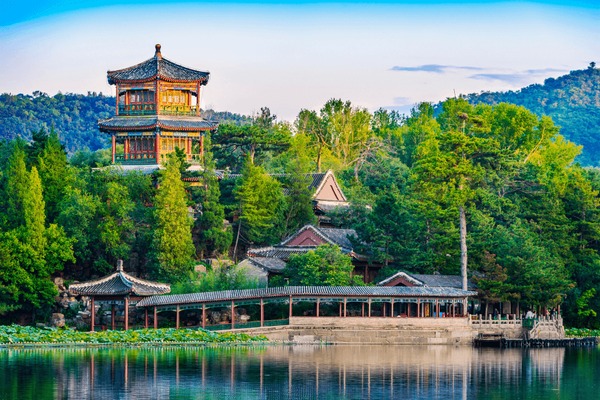
Chengde Mountain Resort.
-
Historical Significance: As a summer palace for Qing emperors, the resort offers a glimpse into the lavish lifestyles and political affairs of China’s imperial past.
-
Stunning Architecture: The classical Chinese architecture, including grand halls, pagodas, and pavilions, showcases the artistry and craftsmanship of the era.
-
Natural Splendor: The resort’s diverse landscapes—from serene lakes to lush mountains—invites visitors to explore its beauty, whether by foot or by boat.
-
Cultural Immersion: With its rich history and cultural artifacts, the resort serves as a living museum, allowing visitors to connect with China’s storied past.
Planning Your Visit
- Opening Hours: The resort is open year-round, with varying hours depending on the season. Be sure to check the current schedule before your visit.
- Entrance Fees: Tickets are priced at 130 yuan from April to October and 90 yuan from November to March, with free admission for children under 1.2 meters tall.
- Accommodation: For an immersive experience, consider spending the night at the Chengde Imperial Mountain Resort Hotel, conveniently located near the main entrance.
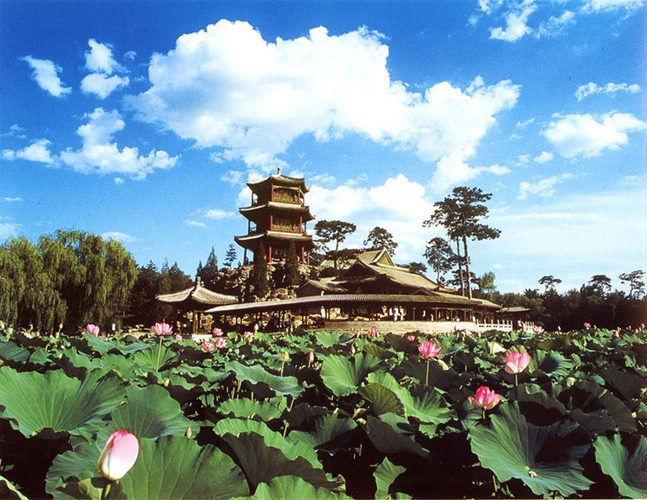
Chengde Mountain Resort.
Whether you are a history buff, a nature lover, or simply in search of tranquility away from the bustling cities, Chengde Mountain Resort promises an unforgettable journey through time and beauty. Prepare to be captivated by the serene landscapes, intricate architecture, and the whispers of history that linger in the air.
The Rich History and Legends of Chengde Mountain Resort
The Chengde Mountain Resort, known as Bishu Shanzhuang (Mountain Manor for Escaping the Summer Heat), is a remarkable testimony to the grandeur of China’s Qing Dynasty. Constructed over nearly 90 years from 1703 to 1792, this expansive imperial garden spans approximately 5.64 square kilometers and is intricately designed to harmonize with the surrounding natural landscape. Recognized as a UNESCO World Heritage site, it stands not only as a stunning architectural achievement but also as a significant cultural landmark reflecting the history and legends of imperial China.
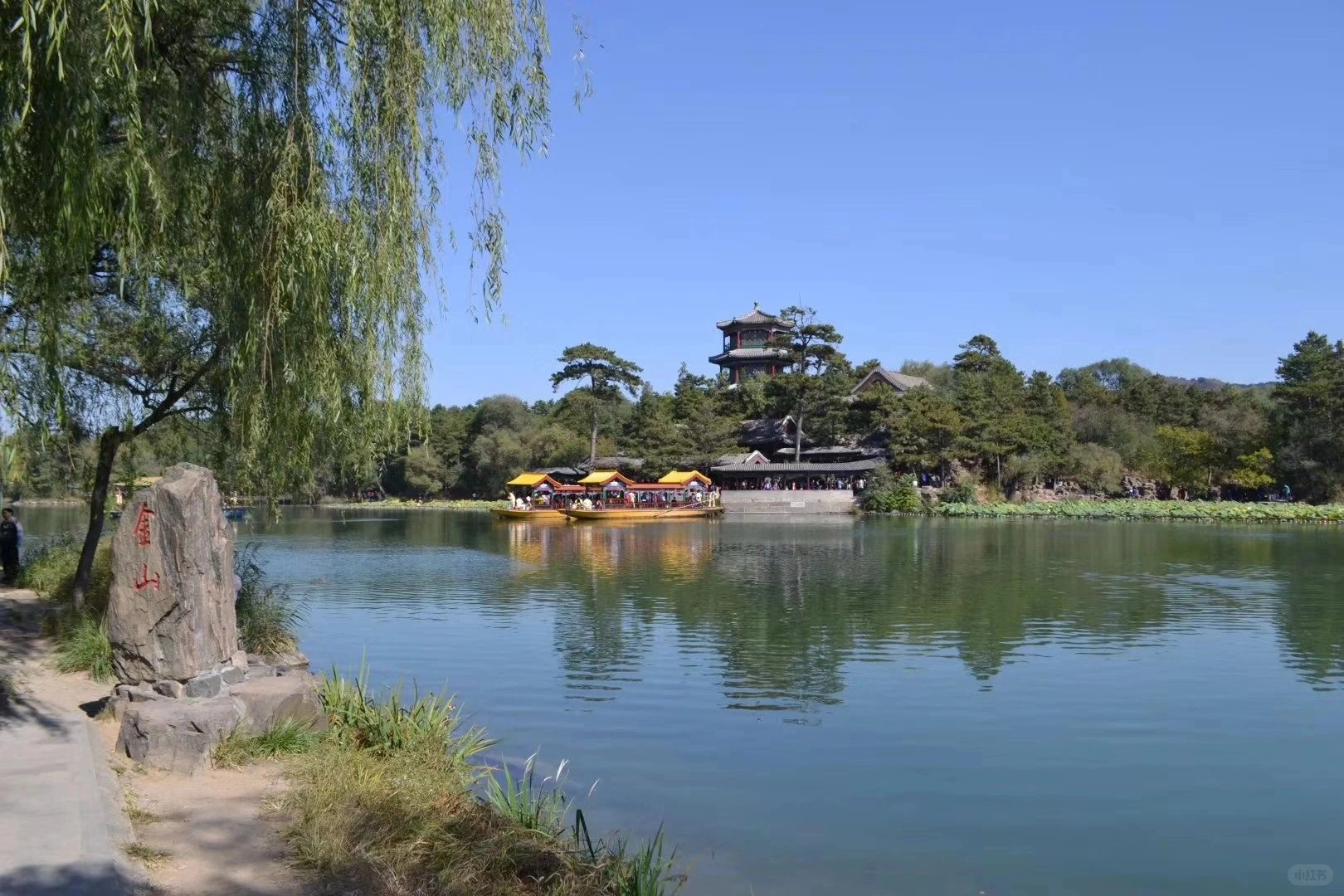
Chengde Mountain Resort.
Origins and Purpose
The resort was commissioned by the Kangxi Emperor as a royal retreat from the sweltering summers of Beijing. The serene environment of Chengde, coupled with its favorable climate, made it an ideal escape for the imperial family. The emperor and his successors, including the Qianlong Emperor, utilized the venue for both leisure and political affairs, immersing themselves in the beauty of nature while attending to the empire’s governance.
Architectural Marvels
Chengde Mountain Resort is a testament to classical Chinese architecture, featuring over 120 groups of buildings that include grand halls, pagodas, pavilions, and temples. The structures are strategically dispersed across four main areas: the Palace Area, Lake Area, Plain Area, and Mountain Area, each embodying distinct architectural styles and functions.

Chengde Mountain Resort.
-
Palace Area: This is where the emperors resided and conducted state business during the summer months. The Main Palace, now a museum, exhibits around 30,000 cultural relics that narrate the region’s rich history. Notable structures like the Danbo Jingcheng Hall and the Yanbo Zhishuang Hall showcase the emperors’ daily lives and ceremonial practices. The latter served as the living quarters for both the Jiaqing and Xianfeng Emperors, who passed away peacefully within its walls.
-
Lake Area: A picturesque expanse adorned with eight lakes and numerous islands, this area features scenic spots reminiscent of traditional Jiangnan gardens. The Shuixin Pavilions and the Pagoda of the Supreme Emperor are highlights, offering visitors stunning views and a glimpse into the leisure activities of the imperial family, who enjoyed fishing, reading, and musical performances here.
Legends and Cultural Significance
The resort is steeped in legends, many of which are tied to the emperors who frequented its grounds. It is said that the Qianlong Emperor, during his 52 summers at the resort, named many of its scenic spots, leaving a legacy of poetic imagery that continues to enchant visitors today. The serene environment is also said to have inspired countless works of poetry and art, reflecting the deep connection between nature and culture in Chinese tradition.
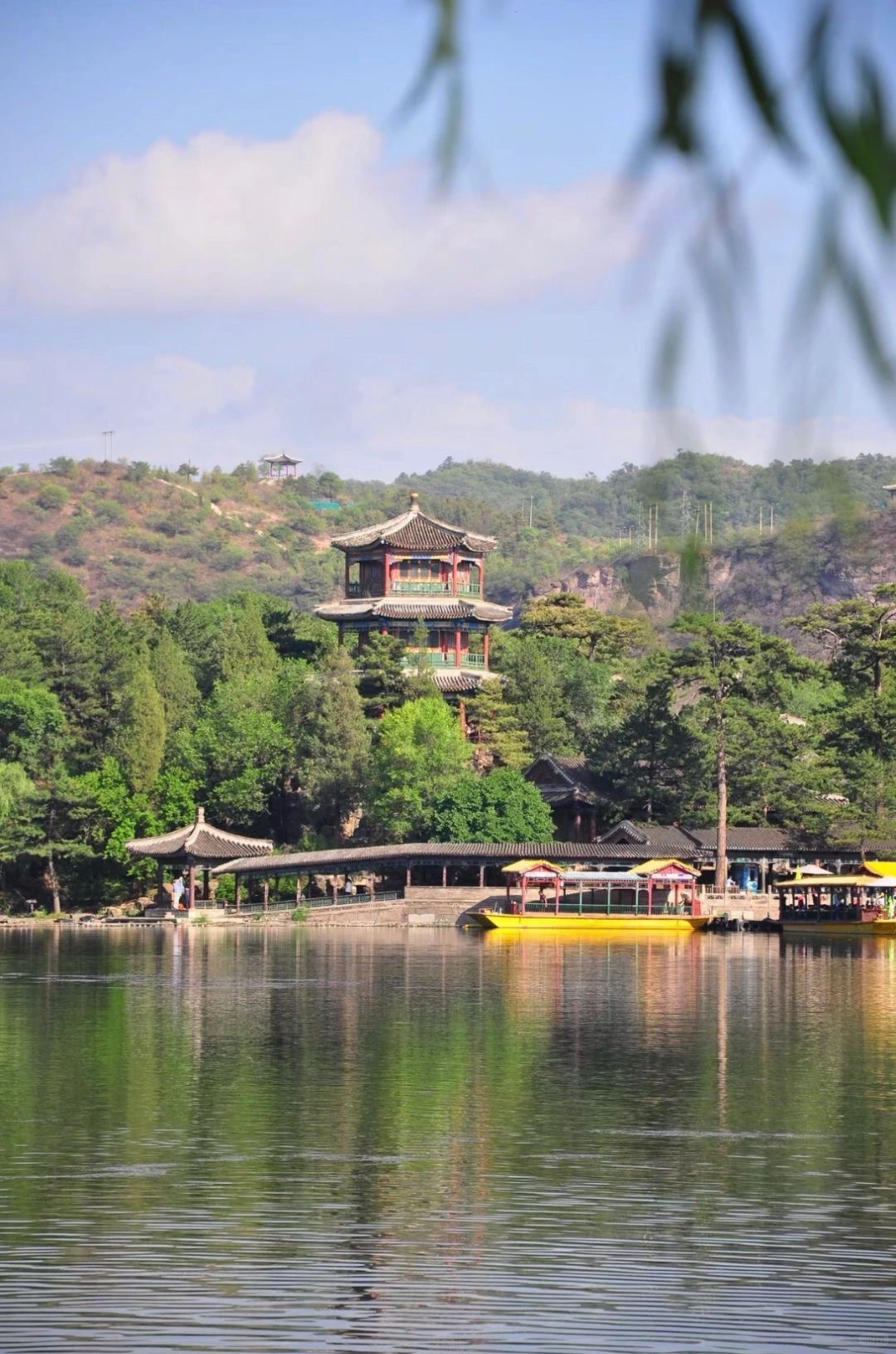
Chengde Mountain Resort.
One famous legend revolves around Rehe Spring, the source of water for the lakes, which never freezes even in winter. This miraculous spring is believed to have healing properties, drawing both locals and travelers alike to its banks, where they seek rejuvenation and solace.
Conclusion
As you explore the Chengde Mountain Resort, you are not merely walking through a historical site; you are stepping into a rich tapestry of Chinese history and culture. The blend of stunning landscapes, exquisite architecture, and enchanting legends provides a unique window into the life of the Qing dynasty and the enduring legacy of its emperors. For international travelers, a visit to this magnificent site is an invitation to connect with the past while reveling in the beauty of China’s natural and cultural heritage.
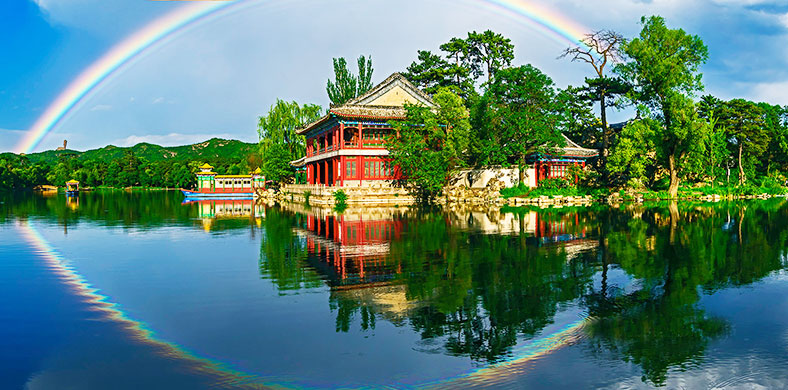
Chengde Mountain Resort.
Main Highlights: What You Absolutely Can’t Miss
Discover the Wonders of Chengde Mountain Resort
Nestled in the serene landscapes of Hebei province, the Chengde Mountain Resort (承德避暑山庄) is a breathtaking UNESCO World Heritage site that offers a captivating glimpse into China’s imperial past. From its stunning architecture to its lush gardens, this historic retreat is a treasure trove of cultural significance and natural beauty. Here are the main highlights that you absolutely can’t miss during your visit.
1. The Palace Area: Heart of Imperial Life
Entering through the Lizheng Gate, you’ll find yourself in the Palace Area, which served as the summer residence for the Qing emperors. This expansive area, covering approximately 100,000 square meters, features nine courtyards where the emperors conducted political affairs and hosted dignitaries. Key sites to explore include:
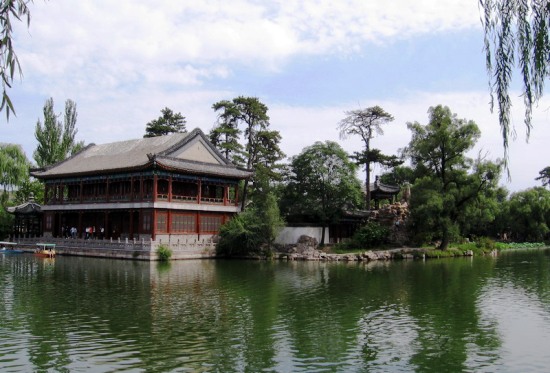
Chengde Mountain Resort.
- Main Palace: Now a museum showcasing over 30,000 cultural relics, including artifacts from the Qing dynasty.
- Danbo Jingcheng Hall: The Hall of Frugality and Placidity, where significant ceremonies took place. Admire the exquisite Nanmu wood architecture and the tranquil surroundings.
- Yanbo Zhishuang Hall: The living quarters of the emperors, featuring a concealed escape door for emergencies—a fascinating peek into imperial security measures.
- Wanhesongfeng Hall: A serene space where emperors engaged in reading and reflection, often accompanied by family.
2. The Lake Area: A Scenic Escape
The Lake Area boasts a picturesque landscape dotted with eight lakes and numerous islands, reminiscent of Jiangnan-style gardens. The best way to explore this area is by taking an electric boat ride, allowing you to soak in the stunning views while visiting must-see sights:
- Shuixin Pavilions: These enchanting pavilions appear to float on water, providing a perfect backdrop for photography.
- Jinshan Mountain: Climb to the summit to see the Pagoda of the Supreme Emperor and enjoy panoramic views of the lakes and surrounding hills.
- Rehe Spring: A natural hot spring that never freezes, even in winter. This spring is the primary water source for the lakes and a delightful spot to witness nature’s wonders.
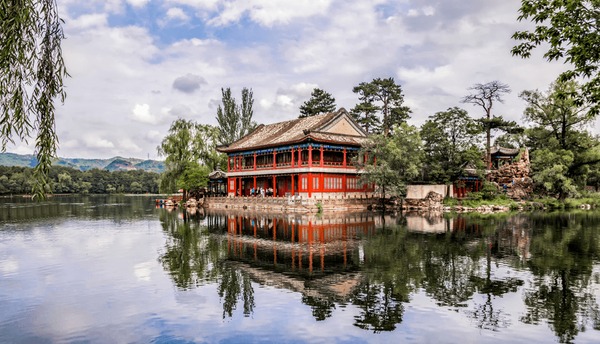
Chengde Mountain Resort.
3. The Plain Area: Cultural Heritage
The Plain Area showcases a collection of traditional temples and pavilions, each steeped in history. Here, you can experience:
- Yongyou Temple: A significant religious site that offers insight into the spiritual practices of the Qing dynasty.
- Wenyuan Lion Forest: Modeled after Suzhou’s famous Lion Grove Garden, this area features intricate rock formations and serene walking paths, perfect for leisurely exploration.
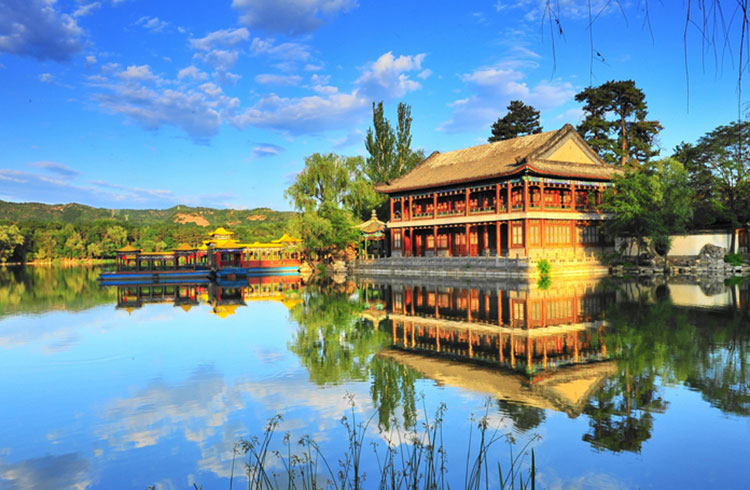
Chengde Mountain Resort.
4. The Mountain Area: Nature’s Majesty
The Mountain Area invites visitors to explore the natural beauty surrounding the resort. This rugged terrain includes:
- Scenic Hiking Trails: Wander through lush forests and enjoy the tranquility of nature, with various trails leading to stunning viewpoints.
- Cultural Landscapes: Discover how the natural surroundings were integrated into imperial garden designs, reflecting the harmony between nature and architecture.

Chengde Mountain Resort.
Practical Information
- Opening Hours:
- April: 7:30 AM – 5:30 PM
- May – October 9th: 7:00 AM – 6:00 PM
-
October 10th – March: 8:00 AM – 5:30 PM
-
Entrance Fees:
- April – October: 130 yuan
- November – March: 90 yuan
- Free for children under 1.2m
Final Thoughts
Chengde Mountain Resort is not just a destination; it’s a journey through time, showcasing the grandeur of the Qing dynasty and the natural beauty of China. To fully appreciate its vastness and significance, consider spending more than a day exploring this historic site. Whether you’re marveling at imperial architecture, cruising across tranquil lakes, or hiking through scenic trails, the Chengde Mountain Resort promises an unforgettable experience steeped in history and culture.
Planning Your Visit: A Practical Guide
Getting to Chengde Mountain Resort
Chengde Mountain Resort, located just north of the city center of Chengde in Hebei Province, is easily accessible by various modes of transport.

Chengde Mountain Resort.
-
By Train: High-speed trains frequently run from Beijing to Chengde, taking approximately 2 to 3 hours. Upon arrival at Chengde Railway Station, you can take a taxi or local bus to the resort.
-
By Bus: Long-distance buses from Beijing, Tianjin, and other nearby cities are a cost-effective way to reach Chengde. The journey usually takes around 3 to 4 hours.
-
By Car: If you prefer to drive, renting a car offers flexibility. The resort is about a 3-hour drive from Beijing via the G101 and G45 highways.
Opening Hours and Entrance Fees
To make the most of your visit, it’s essential to plan your trip around the opening hours:

Chengde Mountain Resort.
- April: 7:30 AM – 5:30 PM
- May – October 9: 7:00 AM – 6:00 PM
- October 10 – March: 8:00 AM – 5:30 PM
Entrance Fees:
- April – October: 130 yuan
- November – March: 90 yuan
- Free for children under 1.2 meters tall
Where to Stay
For an immersive experience, consider staying overnight at the Qiwanglou Hotel, also known as the Chengde Imperial Mountain Resort. This hotel is conveniently located near the main entrance of the Summer Palace, allowing you to explore the resort at your leisure.
Exploring the Resort
The Chengde Mountain Resort is vast, covering approximately 5.64 square kilometers and comprising four distinct areas:
-
Palace Area: This is where the Qing emperors lived and conducted political affairs. Notable buildings include the Main Palace, which now serves as a museum, and the Yanbo Zhishuang Hall, known for its historical significance.
-
Lake Area: Featuring eight scenic lakes interconnected by bridges and paths, this area is ideal for leisurely strolls or boat rides. The Shuixin Pavilions and Jinshan Mountain are must-see attractions here.
-
Plain Area: This area showcases traditional Chinese architectural styles amid lush landscapes, perfect for photography enthusiasts.
-
Mountain Area: Offering more rugged terrain, the mountain area provides stunning views and opportunities for hiking.
Tips for Your Visit
-
Allocate Enough Time: To fully appreciate the beauty and history of the resort, consider spending at least a full day exploring its many attractions, or even longer if you wish to delve deeper into the surrounding temples and natural scenery.
-
Dress Comfortably: Wear comfortable shoes for walking, as you’ll be exploring expansive grounds with diverse terrains.
-
Stay Hydrated: Bring water with you, especially during the warmer months, when temperatures can rise.
-
Respect the Culture: As with visiting any historic site, be mindful of the cultural significance of the locations you visit. Maintain a respectful demeanor, especially in areas where ceremonies or rituals may be held.
Local Cuisine
Don’t miss the opportunity to sample local cuisine while in Chengde. Try the Chengde-style roast duck and various dumplings available in local restaurants. The food here reflects the region’s rich cultural tapestry and is a delightful complement to your historical exploration.
Final Thoughts
Chengde Mountain Resort is not just a visual feast but a deep dive into the history of the Qing Dynasty. Its blend of natural beauty and architectural wonders makes it a must-visit for anyone passionate about Chinese history and culture. By planning ahead, you can ensure your experience at this UNESCO World Heritage site is both enjoyable and enriching.
Tickets: Prices, Booking, and Tips
When planning your visit to the Chengde Mountain Resort, understanding the ticketing system is essential for a smooth and enjoyable experience. This UNESCO World Heritage site, rich in history and culture, offers a variety of ticket options and useful tips to maximize your visit.
Ticket Prices
Ticket prices for the Chengde Mountain Resort vary by season:
- April to October: 130 yuan
- November to March: 90 yuan
- Children: Free admission for children under 1.2 meters tall.
Opening Hours
The resort operates on different schedules throughout the year:
- April: 7:30 AM to 5:30 PM
- May to October 9th: 7:00 AM to 6:00 PM
- October 10th to March: 8:00 AM to 5:30 PM
Booking Your Tickets
Tickets can be purchased at the entrance of the resort. It’s advisable to arrive early, especially during peak tourist seasons, to avoid long queues. If you’re looking to streamline your visit, consider booking tickets in advance through various online platforms that specialize in travel within China. This option can save you time and ensure you have a spot reserved for your preferred date.
Tips for a Memorable Visit
-
Plan for More Than One Day: The vastness of the resort, covering approximately 5.64 square kilometers, means there’s much to explore. If your schedule allows, consider staying overnight at nearby accommodations like the Qiwanglou Hotel for a more leisurely experience.
-
Explore the Four Areas: The resort is divided into distinct sections: the Palace Area, Lake Area, Plain Area, and Mountain Area. Each section offers unique architectural beauty and scenic views, so plan your route accordingly.
-
Consider an Electric Boat Ride: For a unique perspective of the scenic spots, opt for an electric boat ride in the Lake Area. The cost is 90 yuan per person, and this leisurely journey allows you to soak in the beautiful surroundings while visiting various highlights.
-
Dress Comfortably: Given the size of the resort and the varied terrain, wear comfortable shoes and clothing suitable for walking and exploring.
-
Stay Hydrated and Snack Smart: Bring water and some light snacks to keep your energy up as you wander through the beautiful gardens and historical sites.
By keeping these ticketing details and tips in mind, you can ensure that your visit to Chengde Mountain Resort is as enriching and enjoyable as possible. This destination not only invites you to witness the grandeur of imperial architecture but also to immerse yourself in the serene natural beauty that has captivated visitors for centuries.
How to Get There: A Complete Transportation Guide
Getting to Chengde Mountain Resort: Your Comprehensive Transportation Guide
Chengde Mountain Resort, a UNESCO World Heritage site, is not only a breathtaking destination steeped in history but also a well-connected site that is accessible via various modes of transportation. This guide will help you navigate your way to this remarkable imperial retreat, ensuring you arrive comfortably and efficiently.
1. Arriving by Air
Nearest Airport:
The closest major airport to Chengde is Chengde Puning Airport (CDG), located approximately 25 kilometers from the city center. While this airport has limited domestic flights, it is the most convenient for immediate access to Chengde.
Flight Options:
– From Beijing: Expect frequent flights, which take about 1 hour. Airlines such as Air China and China Eastern operate regular services.
– From Other Cities: If you’re coming from cities like Shanghai or Guangzhou, you may need to transit through Beijing, as direct flights to Chengde are limited.
Transportation from the Airport:
Upon arrival, you can take a taxi or arrange for a hotel shuttle to reach the city center or your accommodation. The taxi ride takes around 30-40 minutes, costing approximately 50-80 yuan.
2. Getting There by Train
Chengde is well-connected by train, making it an excellent option for travelers coming from major cities like Beijing and Tianjin.
Train Stations:
– Chengde Railway Station: Located about 5 km from the city center, this is the primary station for travelers.
Train Options:
– From Beijing: High-speed trains (D-trains) from Beijing North Railway Station to Chengde take approximately 2-2.5 hours. Trains run frequently throughout the day, with tickets priced between 60-140 yuan, depending on the class.
– From Tianjin: Take a regular train from Tianjin to Chengde, which takes about 4-5 hours.
Local Transportation:
Once you arrive at Chengde Railway Station, taxis and buses are readily available to take you to the Chengde Mountain Resort or your accommodation.
3. Traveling by Bus
Long-Distance Buses:
Buses from nearby cities also serve Chengde, providing a cost-effective way to reach the resort.
- From Beijing: Buses depart from various stations in Beijing, such as the Liujiayao Bus Station. The journey takes about 3-4 hours, with tickets costing around 40-70 yuan.
- From Tianjin: Similar services are available from Tianjin, with travel times between 4-5 hours.
Local Bus Services:
Chengde has a reliable public bus network. Bus routes connect the city center with the Chengde Mountain Resort. Look for buses heading to the Bishu Shanzhuang stop, which is near the main entrance to the resort.
4. Navigating Within Chengde
Once in Chengde, getting around the city is straightforward:
Taxis:
Taxis are widely available and relatively affordable. Fares start at around 8 yuan, with an additional cost per kilometer. Ensure to have your destination written in Chinese to show the driver.
Public Buses:
An efficient public bus system operates in Chengde, offering low fares (around 1-2 yuan per ride). Key routes include those heading to the Chengde Mountain Resort.
Bicycles:
For the more adventurous, renting a bicycle is a delightful way to explore Chengde at your own pace. Various rental shops can be found near the city center.
5. Accommodation Options Near the Resort
If you’re planning to spend more than a day exploring the Chengde Mountain Resort, consider staying at nearby hotels for convenience. The Qiwanglou Hotel, also known as the Chengde Imperial Mountain Resort, is located close to the main entrance and offers comfortable accommodations for visitors.
Final Thoughts
The journey to Chengde Mountain Resort is as enriching as the destination itself. With a range of transportation options available, you can easily tailor your travel plans to suit your schedule and preferences. Whether you prefer the speed of high-speed trains or the scenic route by bus, your exploration of this historic gem will surely be unforgettable.
Local Cuisine and Accommodation Nearby
Discovering Local Flavors and Comfortable Stays Near Chengde Mountain Resort
Chengde, with its rich history and breathtaking landscapes, offers a delightful culinary scene that reflects the diverse flavors of Hebei province, as well as accommodation options that cater to both comfort and convenience for international travelers.
Culinary Highlights
When exploring the local cuisine, don’t miss the chance to savor Chengde-style dishes that are rooted in traditional Chinese cooking while also showcasing the unique ingredients of the region.
-
Chengde Roast Duck (承德烤鸭)
Similar to its more famous Beijing counterpart, Chengde’s roast duck is known for its crispy skin and tender meat. Served with thin pancakes, sweet bean sauce, and fresh vegetables, this dish is a must-try. -
Mongolian Hot Pot (蒙古火锅)
Given Chengde’s proximity to Inner Mongolia, the city is famous for its hearty Mongolian hot pot. Diners can enjoy a variety of meats, fresh vegetables, and fragrant broths, making for a communal and warming dining experience. -
Chengde Dumplings (承德饺子)
A local favorite, these dumplings are often filled with a mix of fresh vegetables and meats, steamed or boiled to perfection. Many restaurants offer a wide selection, and some even host dumpling-making workshops for an interactive experience. -
Wild Mushroom Dishes (野生蘑菇菜)
The nearby mountains provide an array of wild mushrooms that are commonly featured in local dishes. These mushrooms are often stir-fried or used in soups, showcasing the natural flavors of the region. -
Local Teas (地方茶)
After a hearty meal, relax with a cup of fine Chinese tea. Chengde is known for its high-quality herbal teas, which are believed to have numerous health benefits.
Accommodation Options
For those wishing to immerse themselves in the serene landscape and historical ambiance of Chengde, here are some excellent accommodation choices:
-
Qiwanglou Hotel (奇望楼酒店)
Located conveniently near the main entrance of the Chengde Mountain Resort, this hotel offers comfortable rooms and stunning views of the surrounding landscape. The hotel features modern amenities while preserving a touch of traditional Chinese architecture, making it a perfect starting point for your explorations. -
Chengde Imperial Mountain Resort Hotel (承德避暑山庄酒店)
This hotel provides easy access to the Resort’s vast grounds. Guests can enjoy various services, including guided tours of the surrounding temples and gardens. The architecture reflects the Qing Dynasty style, adding to the historical experience. -
Yulong International Hotel (御龙国际酒店)
A more upscale option, Yulong International Hotel combines luxury with convenience. Offering spacious rooms and a range of dining options, including a restaurant that serves traditional Chinese cuisine, this hotel is ideal for travelers seeking a higher level of comfort. -
Chengde Mountain Resort Guesthouse (承德避暑山庄宾馆)
For those seeking a more homely atmosphere, this guesthouse is a charming choice. It offers cozy rooms and a friendly environment, where guests can learn more about local culture and history from the owners. -
Homestays (民宿)
For a more immersive experience, consider booking a homestay with local families. This option not only provides comfortable lodging but also a unique opportunity to engage with Chengde’s rich traditions and daily life.
Conclusion
Chengde is a treasure trove of cultural heritage and culinary delights, making it an ideal destination for history enthusiasts and food lovers alike. Whether you’re savoring local dishes or resting in one of the city’s welcoming accommodations, your visit to the Chengde Mountain Resort and its surroundings will undoubtedly be a memorable experience.
Frequently Asked Questions
Frequently Asked Questions about Chengde Mountain Resort
1. What are the opening hours for Chengde Mountain Resort?
The opening hours vary by season:
– April: 7:30 AM – 5:30 PM
– May to October 9th: 7:00 AM – 6:00 PM
– October 10th to March: 8:00 AM – 5:30 PM
2. How much is the entrance fee?
– April to October: 130 Yuan
– November to March: 90 Yuan
– Children under 1.2 meters in height: Free
3. How can I get to Chengde Mountain Resort?
Chengde Mountain Resort is conveniently located just north of Chengde’s city center in Hebei Province. You can reach it by public transport, taxi, or by renting a car. If you’re traveling from Beijing, high-speed trains and long-distance buses are available, making it a perfect day trip or weekend getaway.
4. How long should I plan to spend at the resort?
To fully appreciate the vast area and its historical significance, it is recommended to spend at least a full day exploring the Chengde Mountain Resort. If possible, consider staying overnight at nearby accommodations like the Qiwanglou Hotel to enjoy both the natural beauty and historical sights at a leisurely pace.
5. What are the main areas within the resort?
Chengde Mountain Resort is divided into four main areas:
– Palace Area: Where the Qing emperors resided and conducted political affairs.
– Lake Area: Features beautiful lakes and scenic spots for leisurely strolls and boat rides.
– Plain Area: Showcases traditional pavilions and gardens.
– Mountain Area: Offers stunning views and a chance to explore the hilly terrain.
6. Are there guided tours available?
Yes, guided tours are available and highly recommended for visitors interested in learning more about the rich history and cultural significance of the resort. These tours can provide insights into the architecture, the emperors who lived there, and the unique landscape.
7. What should I wear and bring when visiting?
Dress comfortably and wear suitable shoes for walking, as the resort covers a vast area with varying terrains. Bring water, sunscreen, and a camera to capture the stunning scenery and architectural beauty. If you’re visiting in winter, dress warmly, as temperatures can drop significantly.
8. Can I take photographs at the resort?
Yes, photography is allowed throughout the resort, and you’ll find plenty of picturesque spots to capture the beauty of the landscape and the intricate details of the architecture. Just be respectful of any areas where photography might be restricted, especially inside museums or specific buildings.
Final Thoughts on Your Trip
As you prepare to leave the enchanting realm of Chengde Mountain Resort, take a moment to reflect on the rich tapestry of history, culture, and natural beauty that this UNESCO World Heritage site offers. Encompassing over 5.6 square kilometers of lush gardens, tranquil lakes, and architectural marvels, Chengde is not just a destination; it’s a journey through time.
Embrace the Legacy
The resort, built over 90 years during the Qing Dynasty, serves as a poignant reminder of China’s imperial past. From the austere yet dignified Palace Area to the picturesque Lake Area adorned with traditional Jiangnan-style gardens, every corner whispers stories of emperors who sought respite from the sweltering summer heat. As you wander through its historic halls and serene landscapes, allow the echoes of the past to guide your imagination.
Nature’s Serenity
The harmonious blend of nature and architecture at Chengde is truly captivating. Picture yourself strolling along the shores of the lakes or ascending Jinshan Mountain, where the panoramic views offer a breathtaking perspective of the resort’s sprawling beauty. Each element, from the ancient pine trees to the meticulously designed pavilions, contributes to an atmosphere of tranquility that invites introspection and wonder.
A Cultural Mosaic
Moreover, Chengde is a vibrant testament to China’s diverse cultural heritage. The resort not only celebrates Han Chinese architecture but also incorporates elements from various ethnic minority groups, reflecting the unity and diversity of the nation. This cultural mosaic enriches your experience, providing a deeper understanding of China’s historical complexities.
Plan Your Return
If time permits, consider extending your visit to fully immerse yourself in the resort’s splendor. The nearby Qiwanglou Hotel offers a comfortable base for further exploration, allowing you to witness the changing hues of the landscape as the sun rises and sets over this majestic site.
A Journey Worth Taking
In closing, your visit to Chengde Mountain Resort is not just a chapter in your travel story; it’s a meaningful exploration of Chinese history and culture. As you depart, carry with you the memories of this extraordinary place, and let them inspire your future adventures. Whether you are a history enthusiast, a nature lover, or a cultural explorer, Chengde promises to leave an indelible mark on your heart and mind. Safe travels!